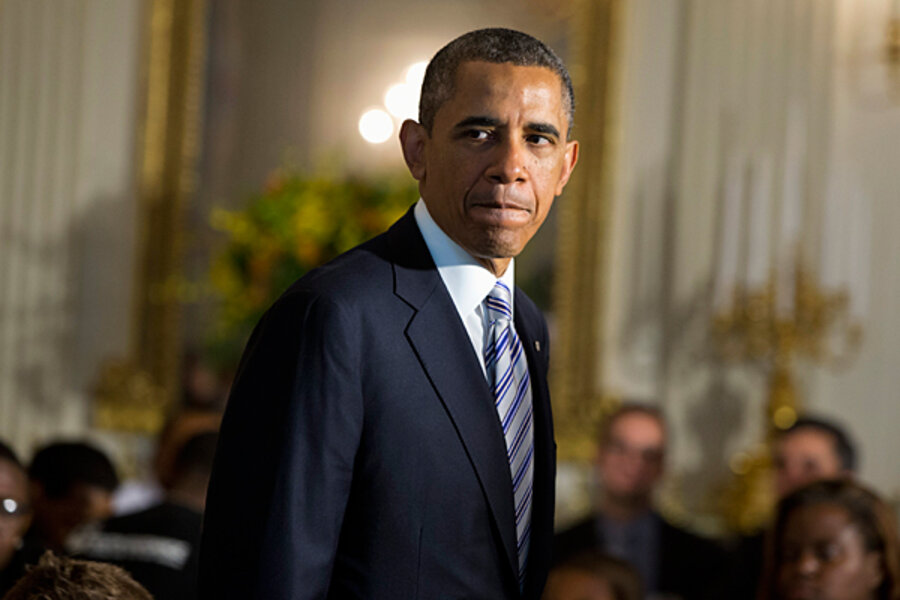US military aid to Syria rebels: Why Obama is starting with the minimum
Loading...
| Washington
President Obama’s decision to send arms to Syria’s rebels is likely to start with the minimum necessary to make good on his pledge to “change the calculus” if Syrian leader Bashar al-Assad were to resort to using his formidable chemical weapons stocks in the country’s civil war.
After determining that Syrian forces used chemical weapons, including small amounts of the nerve gas sarin, in attacks earlier this year that killed as many as 150 people, the White House announced Thursday that Mr. Obama has decided to begin providing “military support” to Syria’s moderate rebels.
But at least initially, the US will provide only light weapons and ammunition, according to administration officials – not the heavy anti-tank and anti-aircraft weapons rebel leaders have been clamoring for. The military aid, to be coordinated by the CIA, might eventually include anti-tank weaponry, but anti-aircraft missiles seem less likely, despite the Assad regime’s stepped-up use of aerial bombardment in the war.
Also among the potential military options is implementation of a no-fly zone over parts of southern Syria abutting Jordan, but Obama has yet to sign off on that idea, officials said.
The White House made it clear that the president’s initial decision might only be the beginning of a deeper US involvement in Syria’s civil war.
“We’ve prepared for many contingencies in Syria,” said deputy national security adviser Ben Rhodes, in discussing the determination of chemical weapons use with reporters Thursday. “We are going to make decisions on further actions on our own timeline.”
But Obama’s cautious shift away from providing only non-lethal assistance to Syria’s rebels reflects continued deep misgivings in the White House about sending US arms into the 26-month-old war, and about broadening the US role in a war that threatens increasingly to become a regional conflagration.
The administration continues to believe that a political settlement among Syria’s warring parties is the only solution to a conflict that has already claimed more than 90,000 lives – a view that has only been bolstered in recent weeks by significant gains on the ground by Assad forces.
While Obama may have had no other choice than to provide some arms to the rebels after the “red line” he set last year for chemical weapons use was crossed, the initial modest military support also reflects a desire not to shut the door on the diplomatic solution the US and other Western powers prefer.
Obama will have a chance to gauge the impact the decision on arming the rebels has had in international circles when he meets next week with Russian President Vladimir Putin at the G8 summit in Northern Ireland.
The US and Russia, Mr. Assad’s most powerful ally, reached an agreement earlier this year to jointly sponsor a Syria peace conference that would aim to deliver a political solution to the conflict. But the initiative has stalled as the two sides in the fighting have placed conditions on their participation, with a conference originally envisioned for May now put off to July at best.
The US also remains deeply concerned that any weapons provided the rebels could end up “falling into the wrong hands,” according to one Pentagon official, who was not authorized to speak publicly on the issue.
The CIA program will include vetting of the rebels who receive any US arms in an effort to keep them out of the hands of the extremist Islamist factions that have gained in strength and numbers over the past year. But US officials worry that sophisticated weapons could be lost or stolen – or otherwise reach rebel forces that do not support US goals for a pluralistic Syria and which could also cause trouble for Israel, the closest US ally in the region.
Such concerns are a key reason that shoulder-fired anti-aircraft missiles so far remain off the list of weapons destined for Syria’s rebels.
Several days of intense White House discussions on Syria this week also took up the idea of a no-fly zone over parts of the country, according to officials.
Obama could decide at some point in the coming weeks to impose what would likely be a very limited version of a no-fly zone over parts of Syria nearest the Jordanian border, some officials say. The idea would be to keep Syrian planes away from areas inside Jordan where rebels train and regroup, and where the CIA is likely to have an increased presence in coming months as it implements the US arms program.
But such a limited no-fly zone appears unlikely to satisfy some hawkish congressional leaders who are pressing for a full-fledged no-fly zone as the only viable option for tipping the Syria balance against Assad.
A no-fly zone that halts Assad’s aerial assaults on Syrian cities is the only way “we can change this equation on the battlefield,” said Sen. John McCain (R) of Arizona, speaking Thursday after the White House announcement.
Providing light weapons and ammunition may keep the rebels fighting, Senator McCain says, but will do nothing to alter the course of the war.








